The MSI GT80 Titan Review: The Broadwell Gaming Laptop Your Desktop Envies
by Brett Howse on June 26, 2015 8:00 AM ESTDesign
When you are discussing an 18.4-inch notebook that comes in at ten pounds, discreet is likely not the correct choice of adjectives. There is little to be discreet about with the GT80 Titan. This is a device crafted for a single purpose, and that is to be used as a desktop replacement which can handle practically any gaming you can throw at it. The first thing that hits you when you see the GT80 is the imposing size. Then you open it up and are greeted by the single design decision that really sets this device apart from all others.
The keyboard is really one of the focal points of this design. Going with a mechanical keyboard was a decision that clearly impacted the entire layout. With the depth required for the switches and their movement, really the only place for the keyboard is at the front. This might seem out of place when comparing it to traditional notebook computers, but when you step back and look at the device for what it is, the design makes a lot of sense. When you are sitting at a desktop, you don’t sit with your hands hovering over the table to do your typing. Your keyboard is in front of everything else, as it is on the GT80. The fact that this is a mechanical keyboard is the icing on the cake. Generally when I am reviewing laptops, keyboards range from mushy to good, but with the Steelseries keyboard with Cherry MX Brown keys, the key feel is just so much more tactile. I do the majority of my writing on a desktop computer because I appreciate the much better keyboard experience, and the GT80 Titan captures a lot of that into a gaming notebook. I do find the key noise to be a bit too much (even though these are not audio feedback switches like MX Blues), but considering the extra feel, it is likely something I could easily come to terms with. For those concerned that the front mounted keyboard means there is nowhere to rest your wrists, fret not. MSI includes a wrist rest in the box which mounts on the front.
Moving the trackpad to the right side to create room for the keyboard is another design decision that is interesting. I had no trouble at all adapting to the new placement, and for a lot of what I needed the trackpad for, having it vertical was actually quite handy. There are two physical buttons at the bottom for left and right click, and in the upper left corner is a numlock area on the trackpad. Tap there, and the LED backlighting turns on a touch based number pad. After praising the inclusion of an actual keyboard on the laptop it would seem odd to hear me praise a touch number pad, and I won’t. It would be useful in a pinch but for anyone who does a lot of data entry, a real number pad would be much more useful. I can’t see any alternative here though, since having this as physical keys would leave no room for the trackpad. But again, if we step back and look at the GT80 Titan for what it is, the decision is fine. This is not a device to enter numbers on a spreadsheet. The GT80 Titan is a desktop replacement focused on gaming, and as such, the odds are that it will be used with a mouse. That frees up the number pad to be used for keyboard mappings of commands in games. I think MSI could do more with this, and include custom software to do macros on the numpad as well. The Steelseries keyboard includes software for key mappings and bindings on the keyboard, but it does not extend out to the trackpad. It would be nice to see this utilised more like the Razer SwitchBlade UI.
Stepping back again to take a look at the device as a whole, MSI has used aluminum as a feature of the client facing materials, and kept the underside and sides of the device as plastic. The LCD lid is one of the aluminum pieces, and it is accented by red backlighting and the MSI logo. It has a brushed finish on the top which is a nice touch. The sides and back of the device are dominated by the large cooling vents which are needed to expel the tremendous heat that this notebook can generate when running at 100%. There are actually eight heat pipes inside in order to move all of the heat to a location where it can be removed.
If you are looking to connect peripherals, MSI has you covered there as well. The GT80 Titan has an HDMI 1.4 port on the rear, as well as two mini DisplayPorts, Gigabit Ethernet, and the A/C in. The left side has three USB 3.0 ports, a SD card reader, a SPDIF audio output, and two 3.5 mm jacks for headphones out and microphone in. There is even a Blu-Ray burner on the left side, because when you have this much real estate to work with, you may as well cover every possibility. The right side features another two USB 3.0 ports. With a total of five USB 3.0 ports, the GT80 Titan should be set for whatever devices you want to connect to it.
Opening the display up shows off the MSI dragon logo on an aluminum top plate. Personally I am not a fan of some of these things on gaming systems, but that is personal preference, and MSI has done a fairly understated job of the logo with the dragon being in a shadow relief compared to the glossy black of the rest of the plate. The keyboard backlighting is in red, as is the red light accent stripe which runs along the top edge of the keyboard. Above this stripe on the right side is the power switch, as well as a hardware switch to disable the NVIDIA GPUs and switch to integrated graphics (there’s no Optimus on the GT80 Titan) and a switch which turns the system cooling to 100%. The latter switch is one that I wish all gaming manufacturers would provide, as it gives the end user the choice about cooling rather than a software policy which may or may not keep the components cool enough.
MSI has also designed the GT80 to be end user serviceable. The top plate can be removed with just two screws, so you can get access to extra memory slots and the storage which features two M.2 SSDs in RAID 0 as well as a 7200rpm 1 TB drive from the factory. The bottom is removable as well to get access to more memory, as well as the MXM graphics cards for future updates. At the moment, there’s no upgrade path from the GTX 980Ms that it has now, but in a year or two users will be able to source new MXM cards with newer GPUs, and they will also come with the correct cooling solution. I think that’s a nice touch when you consider the large investment in a device like this.
With total dimensions of 18” x 13” x almost 2” thick, the GT80 Titan lives up to its Titan name. But it is easy to get caught up in the size, and not look at the total package which is pretty smartly done. This is the first gaming laptop to feature a mechanical keyboard, and the implementation of it was risky but in my opinion has paid off very well.


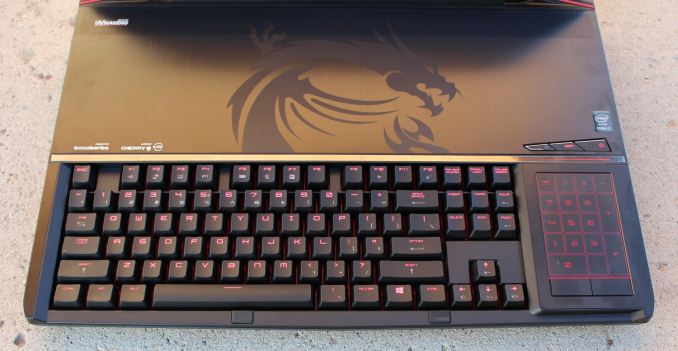
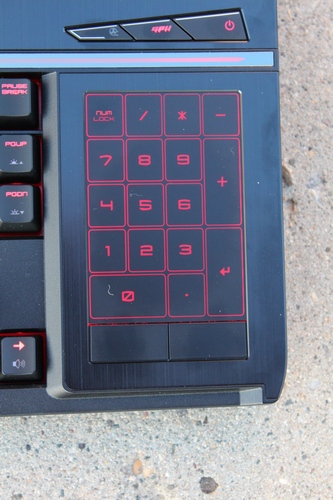
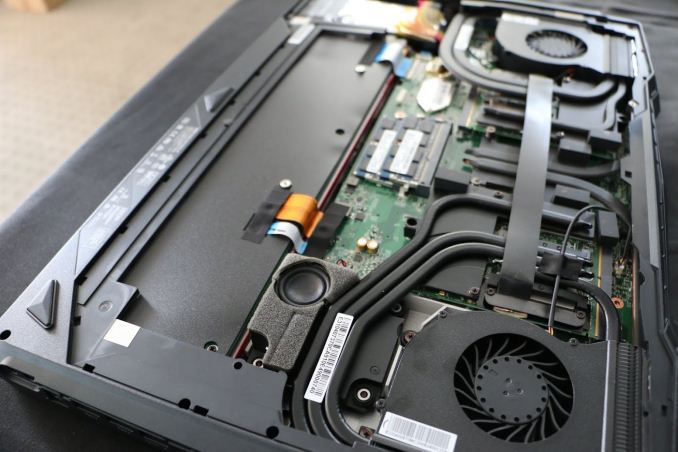



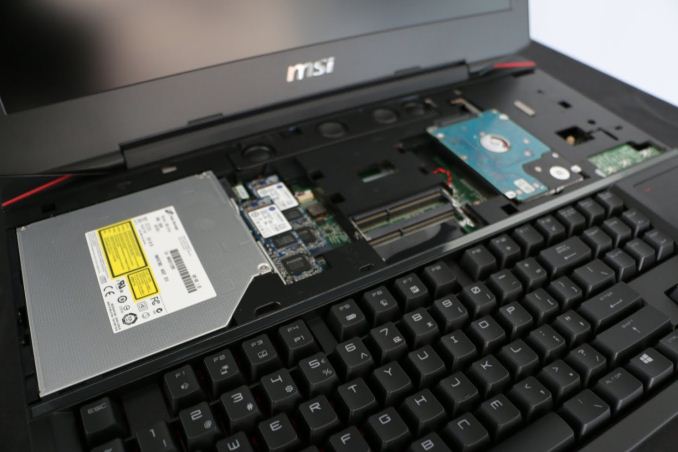
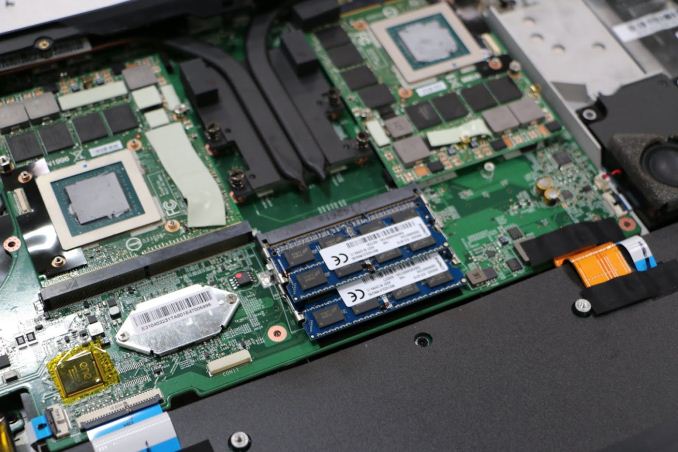








103 Comments
View All Comments
Laststop311 - Friday, June 26, 2015 - link
Man imagine if they would of put a 120 or 144hz panel on this thing. That woulda just rly took it to another level considering it's easily hitting 120 fps+ on games.dali71 - Saturday, June 27, 2015 - link
I'm considering getting a Eurocom X8 for exactly that reason. It's ridiculous to give a laptop that much GPU power, only to cripple it with a 60Hz display.meacupla - Friday, June 26, 2015 - link
"MSI includes a wrist rest in the box which mounts on the front."Are there any pictures of said wrist rest being attached to the laptop?
I mean, I know it's an accessory and all, but if it's a laptop that comes with external accessories, it'd be nice to see the size of all accessories that come with the retail box the laptop came in.
For example, the power brick that came with the initial Xbox 360 was MASSIVE and that added a lot of bulk to the entire package, especially if you wanted to take it over to a friend's house.
JKflipflop98 - Friday, June 26, 2015 - link
I think the power numbers are quite misleading. Why don't you try doing what this laptop is built for and see how long the battery lasts? I didn't see any charts with battery life while actually using those two Titans. I'd wager you get 20 minutes of battery life before you need to plug in again.Notmyusualid - Saturday, June 27, 2015 - link
Having had a string of DTR machines to my name, I can say that gaming tends around the 60 minute mark on battery.The battery ends up being a UPS to most of the machines I've had, but the M18xR2 I have has HD4000 graphics, and I can run for hours using that, but annoyingly, it requires a reboot to activate, and thus gets little real world use.
bennyg - Sunday, June 28, 2015 - link
Most gaming notebooks downclock on battery, too much current draw will overheat the battery. You just do not bother gaming on battery. The strength of this is that you're not tethered to your desk. Though... while not less hassle, it is probably a lot cheaper to just buy 2 desktops of similar power :oSirGCal - Friday, June 26, 2015 - link
If this had G-Sync to the monitor and an M2 PCIe slot for faster still performance storage, I'd buy it in a second... So close though!Laststop311 - Friday, June 26, 2015 - link
Does this laptop use pci-e ssd's? I have a feeling it doesn't since the 2 gpu's will be eating up 16 pci-e lanes. We have to wait for skylake for the 4 extra pci-e lanes from the cpu before we can have sli graphics and pci-e ssd's.Even so I am extremely impressed with this laptop. I truly hope MSI keeps this design going when skylake is released. If MSI releases this exact laptop with skylake and uses the extra pci-e lanes from skylake for pci-e ssd's I will be buying this to replace my m18x. Nothing beats a large 18 inch laptop for portable lan gaming. With this laptop since the keyboard is so nice you don't even need to pack a keyboard and monitor with you when you go. I currently have to carry a keyboard and 24 inch monitor with me as well as the notebook and mouse. With this design all I need is the notebook and mouse.
My wish is they keep this exact same design when skylake comes out and add the option of a XM overclockable skylake flagship mobile cpu so I can overclock it to a solid 4.3-4.5ghz similar to how i overclock the 2960xm to 4.2ghz in my alienware. And use the 4 extra pci-e lanes to make one of the m2 slots a pci-e 3.0 x4 slot and the other one a normal sata slot. If they make this simple tweak I will be buying on day 1.
dominiqueovalle - Saturday, June 27, 2015 - link
when will the anandtech review for the 1080p razer blade come out? if everMamiyaOtaru - Saturday, June 27, 2015 - link
would have preferred a physical numpad. What about cursor control? eh, trackpoint maybe? I'd expect an external mouse to be in use most of the time, and a trackpoint would be fine for backup